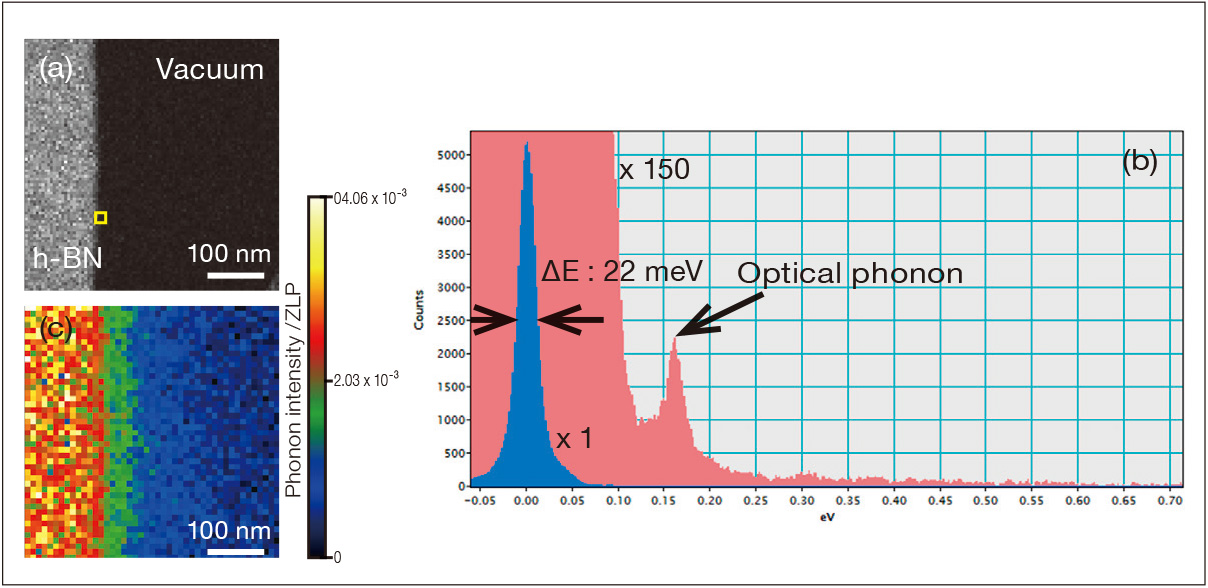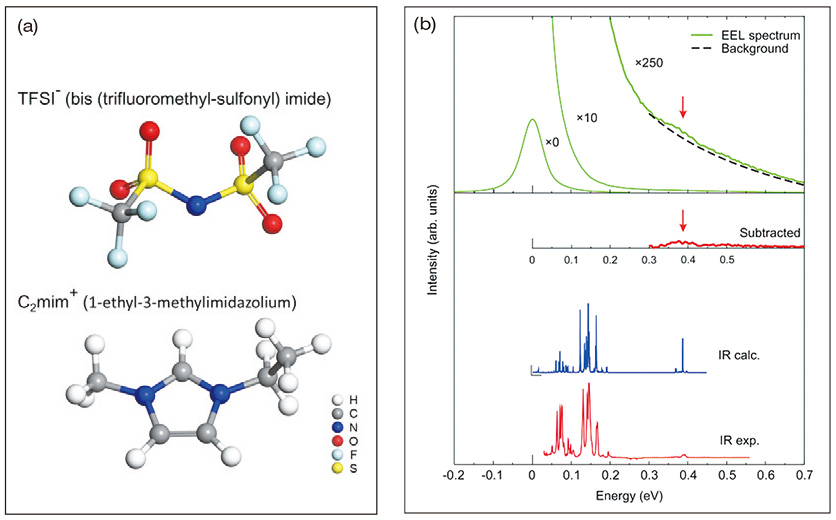Double Wien-filter monochromator for JEM-ARM200F is newly developed to realize ultra high energy resolution EELS analysis at atomic-scale.
特長
Configuration

Double Wien-filter "Spot-IN and Spot-Out system"
The 1st Wien-filter and the electro-static lens produces a focus with energy dispersion of 12.3 μm/eV at the slit plane. At this plane, the electron beam is monochromated by inserting the slit of several widths ranging from few microns to sub microns. The 2nd Wien-filter cancels the energy-dispersion and produces an achromatic and stigmatic focus at exit plane, resulting in the roundly probe on the specimen plane. Thus, since a spot beam from Schottky source becomes a spot again at the exit after the monochromation, we named this monochromator system "Spot-IN and Spot-OUT system".
Sophisticated Octopole Wien-filter
The sophisticated Octopole Wien-filter produces homogeneous dipole field with no undesireble hexapole field from inhomogeneity of dipole field.
Arranged between Schottky source and accelerator
With a preset monochromator setting works universally on every accelerating voltages, since the accelerator is located after the monochromator and axial potential of the monochromator is kept constant.
Mukai M, et al.: (2014) , Ultramicroscopy 140: 37–43.
Energy resolution
With several widths of slits at 60 kV and 200 kV
(0.002 sec. and 0.1 sec. acquisition)
| 60 kV | 200 kV | |||
|---|---|---|---|---|
| Slit width | 0.002 sec. | 0.1 sec. | 0.002 sec. | 0.1 sec. |
| 0.1 μm | 24 meV | 28 meV | 30 meV | 40 meV |
| 0.25 μm | 28 meV | 32 meV | 40 meV | 45 meV |
| 0.5 μm | 36 meV | 36 meV | 45 meV | 50 meV |
| 1.3 μm | 80 meV | 80 meV | 90 meV | 90 meV |
| 2.0 μm | 120 meV | 124 meV | 130meV | 130meV |
| 2.8 μm | 172 meV | 172 meV | 180 meV | 185 meV |
| 4.0 μm | 248 meV | 248 meV | 260 meV | 260 meV |
With multiple acquisitions (0.25 μm slit)
The table shows energy resolution with slits of different widths at 60 kV and 200 kV. Zero-loss spectra were obtained with acquisition times of 0.002 sec. and 0.1 sec. The ultimate energy resolutions of 24 meV for 60 kV and 30 meV for 200 kV with 0.002 sec acquisition with the slit of 0.1 μm. The energy resolutions with 0.1 sec and 0.002 sec acquisitions show only a slight decrease in the energy resolution, which shows that the electrical and mechanical stabilities of the monochromator are good.
The figure displays an intensity profile of zero loss spectrum obtained with 0.002 sec acquisition at 30 kV, showing the energy resolution of 14 meV.
Zero-loss spectrum (ΔE: 14meV @30kV, 2ms)

Spatial resolution
Raw HAADF-STEM images of Si [110] and their Fourier transforms with different energy width at 200 kV and 60 kV. Although a loss of current is inevitable by the slit, this comparison demonstrates that the lattice resolution in STEM is unaffected by the monochromator. Both power spectra on 4μm and 0.25μm slit showed the isotropic resolutions. Thus, with the monochromator with the double Wien-filter system, a round monochromatic electron probe is obtanable with atomic resolution at any energy resolution due to "Spot-IN and Spot-OUT system".

Application 1 phonon of hBN
Vibrational spectrum of optical phonon from Hexagonal BN ΔE: 20meV @30kV

Low-loss EELS map of a hexagonal boron nitride (h-BN) with a monochromatic probe using a 0.1 μm slit. probe size = 1 nm, probe current = 10 pA, acquisition time for each pixel = 0.3 seconds. (a) shows the ADF-STEM image the mapping area. (b) shows the extracted low-loss spectrum from the edge of the specimen indicated with the framed yellow square in Fig. (a). This spectrum, measured with ΔE = 22 meV, showed a peak corresponding to an optical phonon at 170 meV. (c) shows the EELS map at the phonon energy. The phonon intensity was delocalized at the vacuum area > 100 nm beyond the sample edge due to the delocalization of inelastical scattering of electrons.
Application 2 surface plasmon resonance
Surface plasmon resonance (Gold nano-rod) ΔE: 30meV @60kV

The results of EELS map to obtain the surface plasmon resonance using gold nano-rod, recorded at 60 kV with the energy spread of 30 meV. The probe current was 75 pA and acquisition time per pixel was 0.15 seconds. (a) HAADF, (b) low loss spectrum extracted from data cube of the spectrum imaging, (c) EELS maps of 0.1 eV energy width

Application3 Vibrational spectrum of a molecule
Vibrational spectrum of C-H stretching from ionic liquid ΔE: 30meV @60kV

(a) Structure of ionic liquid C2mim-TFSI, which is composed of [C2mim+] cation and [TFSI-] anion.
(b) The EEL spectra, calculated and experimental IR spectra with energy scale.
EELS magnified by ×1, ×10 and ×250 spectra are shown. In the ×250 magnified EEL spectrum, a broad peak, indicated by an arrow, appears at -0.4 eV,. This low-energy peak was confirmed to match the vibrational peaks in the IR spectrum (~3000cm-1) and was attributed to the C-H stretching vibrations of the [C2mim+] cations using theoretical calculations.
Sample courtesy of Dr. Mizoguchi, The University of Tokyo
T. Miyata, et al.: (2014) in Microscopy.
ギャラリー
Movie
Easy Monochrometor Operation "Setting and changing the energy resolution"
◆Click the "replay" button in the box above, and the movie will start(about 7 min.)◆



